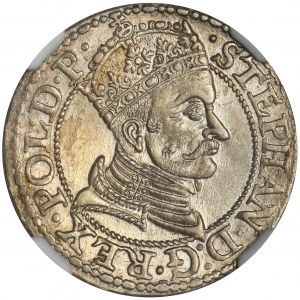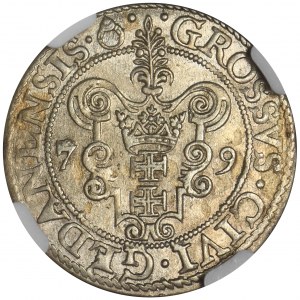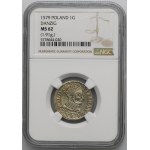Variety with a dot on the obverse ending the inscription. On the reverse the ring mark, Jan Goebel, and above the coat of arms of Danzig a sprig of laurel with berries.
A beautifully preserved piece with mint luster, excellent detail and fine patina.
The second and last vintage of Batory's Danzig pennies.
After the great monetary reform of Sigismund the Old, there was a period of stagnation of several decades, which over time turned into monetary chaos. At the threshold of Stefan Batory's reign, coins of the last two Jagiellons were in circulation, as well as foreign coins. It was essential for the new king to put monetary issues in order. Stefan Batory's Great Reform of 1578-1580 is one of the most important in the history of Polish minting. It included, among other things: the issuance of stable and full-value money, the linking of the Republic's monetary system with the imperial system, and the final implementation of the Polish-Lithuanian monetary union. The system introduced in 1580 functioned until the end of Stefan Batory's reign and for much of his successor's reign (until 1601). During the reign of Stefan Batory, the following mints were in operation: crown mints (Olkusz, Poznan), Lithuanian mints (Vilnius), Prussian mints (Malbork), and municipal mints (Gdansk, Riga). In addition, Lithuanian two-dollars were issued by the Kurland mint in Mitava, while the king had crown thalers and ducats minted at the Transylvanian mint in Nagy Banya. Minting associated with the reign of Stefan Batory also includes Danzig siege coins from 1577.
Stefan Batory's pennies were minted from V ¾-ounce sterling silver. They weighed an average of 1.904 grams and contained 0.684 grams of pure bullion. They were issued by the Crown mint in Olkusz (1579-1582), by the Lithuanian mint in Vilnius (1580-1581) and by the municipal mints in Gdansk (1578-1579) and Riga (1581-1584). In 1580-1581, a series of crown pennies were minted, definitely different in style from the Olkusz pennies. In the catalog of J. Parchimowicz and M. Brzezinski, they were described as "pennies of unknown origin." It should not be ruled out that we are dealing here with forgeries of the period. In addition, a series of siege pennies (with a significantly lowered silver sample) was issued in Gdańsk in 1577. Olkusz pennies have a portrait of the king and an obverse inscription on the obverse. The reverses, on the other hand, are very different. They feature the coat of arms of Poland alone or the White Eagle and Pogo, the coat of arms of the Three Teeth of Batory in various places (the coat of arms of Batory does not appear on some varieties), the coat of arms of Glaubicz of the treasurer Jakub Rokossowski or the coat of arms of Jastrzębiec of the mint manager Piotr Zborowski and his initials "P - Z" or the coat of arms of Przegonia of the new treasurer Jan Dulski placed in a shield or without a shield. The iconographic scheme of the Olkusz groszes stabilized and was devoid of errors only in 1581, after Jan Dulski became treasurer (obverse - portrait of the king, otolithic inscription; reverse - crown, White Eagle, Pogo, Three Teeth, in the otolithic inscription at the bottom Przegonia and at the end the date). The drawing of Lithuanian groszes was as follows: obverse - portrait of the king and a surround inscription; reverse - under the crown the coats of arms of Poland and Lithuania, Three Teeth, on the sides the date, a surround inscription. The Gdansk pennies bore the coat of arms of Gdansk instead of the state coats of arms, while the Riga pennies bore the coat of arms of Riga. On the other hand, the siege pennies of 1577 bore the image of Christ and the inscription DEFENDE NOS CHRISTE (protect us Christ) on the obverse, and the coat of arms of Gdansk and the obverse inscription on the reverse. When the mint manager changed and Kasper Goebel was replaced by Walter Tellemann, a jackdaw - his mint mark - appeared at the top of the reverse.










